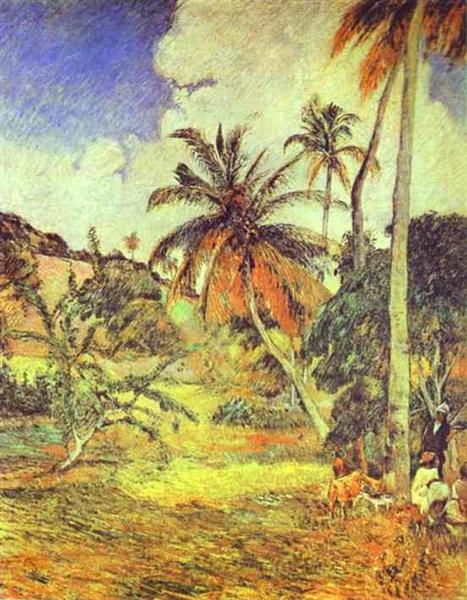Description
Paul Gauguin's painting "Palm Trees in Martinique" (1887) is a fascinating work that encapsulates the duality of Post-Impressionism, combining the exploration of color and form with a deep symbolic charge. In this work, Gauguin evokes his experience on the island of Martinique, a place that inspired his search for aesthetic and spiritual truth far from industrial Europe. This work is characterized by its simple yet powerful composition, which is dominated by a series of palm trees that stand in an almost tropical setting, creating a sense of isolation and refuge.
The use of color is central to the work. Gauguin applies a vibrant palette that captures the essence of Caribbean vegetation. The deep greens of the leaves appear fresh and vibrant, while the sky is rendered in a deep blue, often contrasted with yellow and orange hues that suggest a warm and luminous atmosphere. This use of color is not merely descriptive; instead, it becomes a means of conveying the artist’s emotion and perceptual experience. The way the colors interact with each other reveals Gauguin’s unique approach: the hues do not merely replicate reality, but convey sensations.
The visual composition is built from the repetition of shapes, where the palm trees, with their stylized trunks and characteristic crowns, become the structural elements that guide the viewer's gaze. The way they are grouped suggests both the richness of the landscape and a kind of natural dance, where each tree seems to come to life. There is an evocation of freedom and wildness, which is contradicted by the serenity of the environment. This is characteristic of the symbolism that Gauguin would begin to explore, in his search to capture the essence and spirit of what he represented.
An interesting aspect of “Palm Trees in Martinique” is that, although it does not feature any human figures, the presence of these palm trees can be interpreted as a symbol of the connection between nature and spirituality, a theme that Gauguin would explore further in later works. During his time in Martinique, Gauguin was drawn to the idea of a simpler life, a quest that is evident in his approach to nature. The fact that his work focuses on flora rather than the humanized landscape can be interpreted as an act of celebrating the natural world in its purest state.
This painting can be contextualized within Gauguin's overall output, who, in the late 1880s, was beginning to move away from Impressionism towards a more personal and emotive style. His unconventional use of color and form prefigures the developments he would make in his later works in Polynesia, where he would continue to explore themes of spirituality and indigenous culture. In "Palm Trees in Martinique," we can already glimpse his longing for a deeper connection with the primitive and the authenticity he had sought.
In short, “Palm Trees in Martinique” is a work that encapsulates Gauguin’s quest for an art that goes beyond mere representation, inviting the viewer to reflect on the relationship between man and nature. Its bold use of color, dynamic composition, and implicit symbolism make this painting a testament to Gauguin’s artistic evolution, as well as a milestone within post-impressionist painting. The work, although loaded with simplicity in its subject matter, is enriched with meanings that invite deeper contemplation, revealing the singular vision of an artist who ventured into the search for the essence of being.
KUADROS ©, a famous painting on your wall.
Hand-made oil painting reproductions, with the quality of professional artists and the distinctive seal of KUADROS ©.
Painting reproduction service with satisfaction guarantee. If you are not completely satisfied with the replica of your painting, we will refund 100% of your money.

